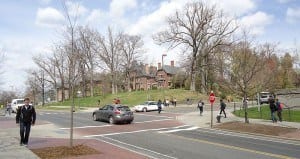
Federally-subsidized loan rates will increase for next year’s amounts
Interest rates on government-subsidized Stafford student loans doubled on July 1 from 3.4% to 6.8%, and this hike will affect an estimated seven million students who plan to take out government-subsidized student loans this year.
Partisanship on Capitol Hill is causing several problems with this issue, as the seemingly ever-present gridlock prevented a solution before the deadline. House Republican leaders returned to Capitol Hill on Monday after the legislators’ one week break, and immediately blamed Senate Democrats and the White House for the lack of action.
“It’s time for the president to lead and it’s time for him to bring his Senate Democrat leaders together and develop a solution. The House has done its job. It’s time for the Senate and the White House to do its job,” House Speaker John Boehner said at a news conference on the steps of the Capitol surrounded by other House GOP leaders and college-age students.
Senate Democratic Leader Harry Reid brushed off Boehner’s criticism that Senate Democrats have failed to act. “Right now, what they’ve done over there is worse for students than doing nothing at all. The legislation passed in the House would balance the budget on the backs of struggling students. Attempt to balance it at least,” Reid said on the Senate floor.
This summer’s fight is similar to last year’s when rates were about to double, when Republicans opposed the Democrat’s proposals to keep the rates at the 3.4% level, saying any new costs for government-backed loans had to be paid for with budget cuts in other programs.
But just ahead of the deadline, while in the midst of a presidential election, a negotiation was figured to offset costs for subsidizing the loans and the 3.4% rate was extended to July 1, 2013.
And in order to beat accusations that they didn’t have a plan, the Republican-controlled House passed a bill in May—over a month before the deadline—that would rework the method of calculation for student loans.
Then instead of a further extension to keep the rate static the House bill pegged interest rates for government-backed student loans to the 10-year Treasury note plus another 2.5%. It passed along party lines, with the support of only four Democrats.
The House bill was similar to the approach in President Barack Obama’s budget, which also tied interest rates for student loans to the longer-term Treasury note. A bipartisan group of senators introduced a compromise bill at the end of June that was close to the House passed bill, but Senate Democratic leaders have not welcomed it since it doesn’t include a cap for interest rates should economic conditions change and interest rates spike.
Democratic Sen. Tom Harkin, who chairs the Senate panel on education, opposed that framework, and has been pushing a proposal to simply extend the 3.4% subsidized rate for student loans for another year.
Reid has scheduled a procedural vote for Wednesday on a bill restoring the interest rate on subsidized Stafford loans to 3.4%. This would initiate debate on another one-year extension. But Republicans, possibly backed by some Democrats, are expected to block this measure in support of a broader solution.
While partisan factions ratchet up their rhetoric and attempt to slam the blame on each other, the differences between the major proposals on student loan interest rates are not significant. But it’s not apparent whether there will be any real effort to resolve this before the next congressional recess in August.
Congress can retroactively reduce interest rates and few students sign loans before August. At that time when members go home for a month, they’ll likely hear more frustrations from students about the inability of Congress to reach a deal.















